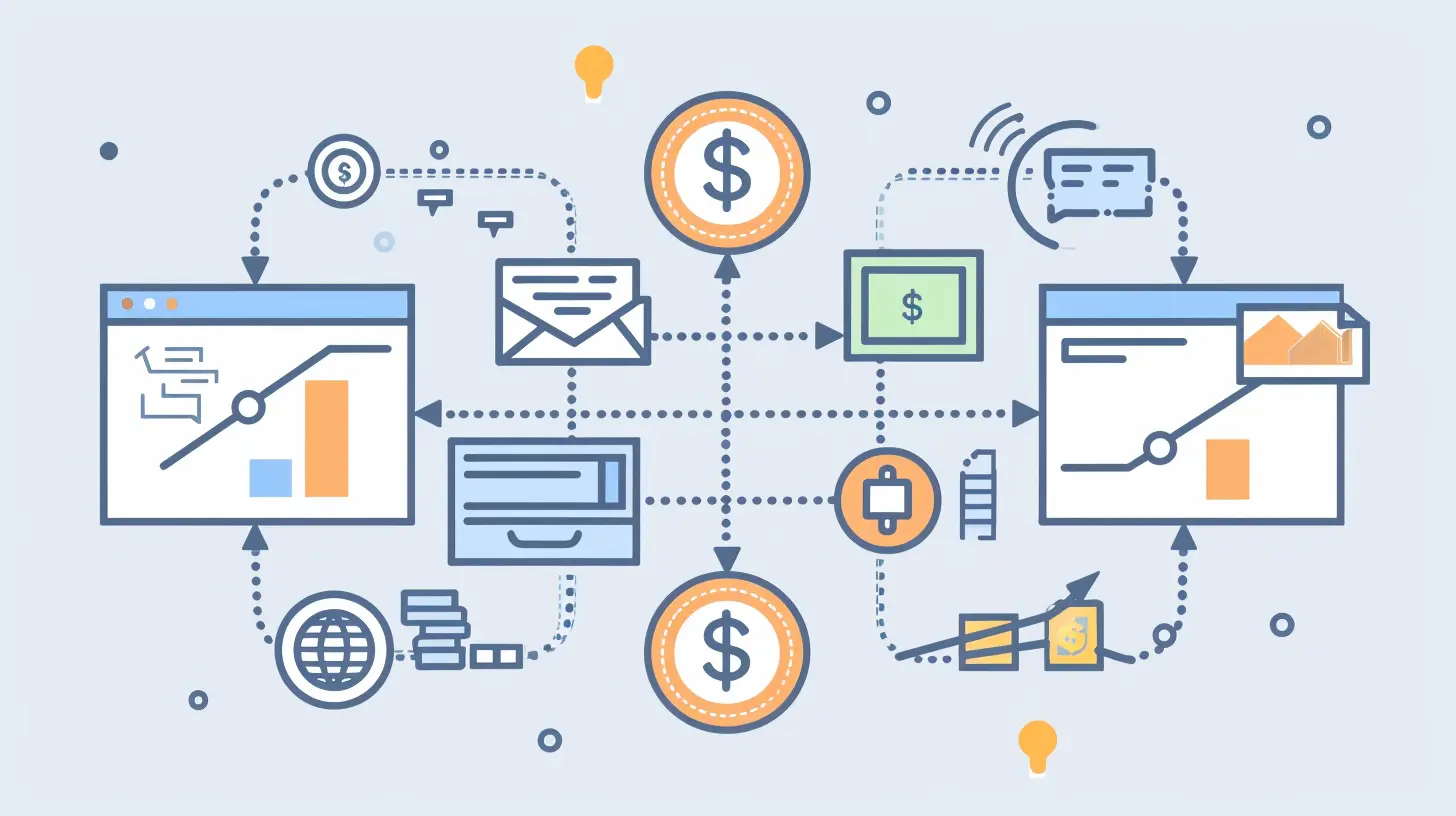The Connection Between Cash Flow Forecasting and Business Planning
18 November 2025
Let’s get real for a second—running a business isn’t a walk in the park. Whether you’re managing a startup or a thriving enterprise, the struggle to balance income and expenses is just... real. That’s where two heavyweight champions step in: cash flow forecasting and business planning. Think of them as your GPS and fuel gauge. One helps you map the journey, and the other tells you if you’ve got enough gas to get there.
But here’s the kicker—these two aren’t just related. They’re deeply connected, like peanut butter and jelly, Batman and Robin, coffee and Monday mornings. In this article, we’ll unpack how predicting your cash flow powers smarter planning, sharper decisions, and less sleepless nights. Ready? Let’s dive in.
What Is Cash Flow Forecasting, Anyway?
At its core, cash flow forecasting is just predicting how much money is going to come in and go out of your business over a given period—weekly, monthly, quarterly, or even yearly.Imagine checking the weather before a road trip. You look ahead to avoid storms. Forecasting cash flow is exactly that but for your money. It helps you see whether your business is heading into a sunny season or a financial downpour.
Why Do Businesses Need It?
Because guessing is not a strategy.Cash flow forecasting gives you:
- A clear picture of your liquidity (can you pay your bills next month?).
- A heads-up on potential shortfalls.
- Insights for when to invest or when to hold off.
- Confidence when applying for loans or pitching investors.
In short, it’s your crystal ball.
How Does Business Planning Fit In?
Now let’s talk about business planning. This is the roadmap for your business journey. It includes your goals, strategies, target market, financial projections, and growth plans.Where cash flow forecasting looks at the “how much” and “when,” business planning answers the “what” and “why.”
So, What’s the Big Picture?
Here’s the sweet spot: your business plan sets the direction, while your cash flow forecast ensures you’ve got the resources to get there. Without cash, even the best-laid plans fall flat. No money = no momentum.Let’s say your big goal for Q2 is to expand into a new market. Awesome. But can you afford that extra warehouse space, marketing blitz, or additional staff? That’s where your forecast steps in and either gives you the green light—or tells you to pump the brakes.
The Symbiotic Relationship: Where Strategy Meets Realism
Cash flow forecasting isn’t just a spreadsheet chore. It’s the bridge between planning and execution. Let’s break down how they feed each other.1. Informs Strategic Decisions
Planning to launch a new product line? Hire a team? Run a national campaign? Great! But before you dream big, your cash flow forecast checks if you can back those dreams with dollars.Without a money map, you’re just rolling the dice.
2. Highlights Gaps in Planning
Think of your forecast like a reality check. You might plan to double your revenue, but if cash outflows are skyrocketing due to fixed costs or delayed receivables, your plan needs tweaking.Forecasting keeps your plans grounded, not fueled by false optimism.
3. Helps Mitigate Risk
Let’s be honest—surprises in business rarely bring balloons and cake. They’re usually unexpected costs, slower-than-expected sales, or customer delays in payments.A well-structured cash flow forecast helps you prepare for these “surprises.” It’s like carrying an umbrella in your bag just in case.
4. Enhances Investor and Lender Confidence
If you’re trying to win over investors or banks, they won’t just want to hear your growth story. They’ll want to know: Can you manage money? Can you survive a downturn? Are you thinking ahead?Forecasting proves you’re not just dreaming—you’ve got the data and a plan to back it up.
Building a Forecast That Actually Works
Okay, so you're convinced that forecasting is important. But how do you build one that's useful and not just a piece of paper collecting digital dust?Step 1: Start With Historical Data
Your past tells a story. Look at the last 12 months and identify patterns in:- Sales cycles
- Seasonal trends
- Recurring expenses
- Payment timings
Use that as the foundation. If you’ve been in business a while, this will give you a solid base. If not, use industry benchmarks or best estimates.
Step 2: Identify Cash Inflows
This includes:- Sales revenue
- Loan proceeds
- Tax refunds
- Investment income
- Any other incoming cash
Be realistic. It’s better to be slightly conservative than overly optimistic.
Step 3: List Out Cash Outflows
Think payroll, rent, utilities, loan repayments, marketing spend, vendors, and other overheads. Don’t forget the sneaky costs like annual software renewals or tax payments.Step 4: Map It Out Monthly (or Weekly)
Weekly forecasts are great if you’re in a cash-tight business (like retail or hospitality). Monthly works well for most companies with a bit more buffer.Step 5: Review and Adjust Constantly
Forecasting isn’t a “set it and forget it” kind of task. It needs revisiting—often. Market changes? Sales aren’t where you expected? Adjust your forecast. This keeps it useful and relevant.Real-Life Scenarios: The Power of Forecasting in Planning
Let’s look at how forecasting directly influences your ability to plan.🏢 Scenario 1: Planning a Major Expansion
You want to open two new stores by the end of the year. Ambitious? Definitely. Doable? Maybe—but only if your forecast shows that after current expenses, you’ll have the capital (or can access it via funding) to support up-front costs like rent, staffing, licensing, and stock.Without cash flow insights, you’re driving blind.
👨👩👧👦 Scenario 2: Hiring Staff
You’re growing, and the workload is insane. Time to hire! But salaries, onboarding, benefits, and even office space costs add up. Your cash forecast tells you whether that new hire makes sense now or three months from now.📉 Scenario 3: Bouncing Back from a Setback
Maybe you just hit a rough patch—sales dipped, or a client defaulted. If you’ve been forecasting regularly, you’ve likely set aside a cash buffer or can spot areas to cut back temporarily. Your business plan pivots, but your forecast keeps the wheels turning.Common Mistakes and How to Avoid Them
Yep, even the best of us mess up sometimes. But knowing where people usually slip up helps you avoid the same traps.❌ Overestimating Revenue
Optimism is great—blind faith, less so. Always include a best-case, expected-case, and worst-case scenario in your forecast.❌ Ignoring Payment Terms
If your clients take 60+ days to pay and you’re paying suppliers every 30, your cash flow could quickly become a mess. Time your inflows and outflows realistically.❌ Not Updating the Forecast
Your forecast should be a living, breathing document. Update it regularly to reflect changes in business conditions.❌ Treating It Like a Chore
If you don’t use your forecast to actively shape decisions, what’s the point? Make it part of your business rhythm—something you check and refine just like KPIs or customer feedback.How Tech Can Make Things Easier
Good news: you don’t have to do this all in Excel anymore (unless you love spreadsheets—if that’s you, power to you!).There are amazing tools out there—like Float, Pulse, and Forecast—designed specifically for small to medium businesses. These integrate with accounting software like QuickBooks or Xero to pull data and create dynamic forecasts on the fly.
These tools make it easier to spot trends, run scenarios, and make decisions based on real-time data.
Final Thoughts: Planning Without Forecasting Is Just Guessing
Here's the bottom line—cash flow forecasting isn’t just another item on your accounting to-do list. It’s the heartbeat of smart and actionable business planning.When you connect the dots between your forecast and your plan, you’re not just winging it. You’re building a business that’s prepared, agile, and ready for whatever comes next.
So next time you sit down to chart out your goals, ask yourself: What role is cash flow playing in your plan?
Because if it isn’t playing one, it should be.
all images in this post were generated using AI tools
Category:
Business PlanningAuthor:

Miley Velez

